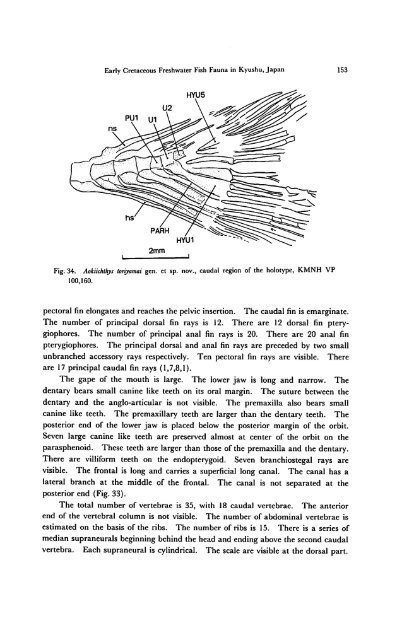Early Cretaceous Freshwater Fish Fauna in Kyushu, Japan
Early Cretaceous Freshwater Fish Fauna in Kyushu, Japan
Early Cretaceous Freshwater Fish Fauna in Kyushu, Japan
You also want an ePaper? Increase the reach of your titles
YUMPU automatically turns print PDFs into web optimized ePapers that Google loves.
<strong>Early</strong> <strong>Cretaceous</strong> <strong>Freshwater</strong> <strong>Fish</strong> <strong>Fauna</strong> <strong>in</strong> <strong>Kyushu</strong>,<strong>Japan</strong> 153<br />
Fig. 34. Aokiichthys toriyamai gen. et sp. nov., caudal region of the holotype, KMNH VP<br />
100,160.<br />
pectoral f<strong>in</strong> elongates and reaches the pelvic <strong>in</strong>sertion. The caudal f<strong>in</strong> is emarg<strong>in</strong>ate.<br />
The number of pr<strong>in</strong>cipal dorsal f<strong>in</strong> rays is 12. There are 12 dorsal f<strong>in</strong> ptery<br />
giophores. The number of pr<strong>in</strong>cipal anal f<strong>in</strong> rays is 20. There are 20 anal f<strong>in</strong><br />
pterygiophores. The pr<strong>in</strong>cipal dorsal and anal f<strong>in</strong> rays are preceded by two small<br />
unbranched accessory rays respectively. Ten pectoral f<strong>in</strong> rays are visible. There<br />
are 17 pr<strong>in</strong>cipal caudal f<strong>in</strong> rays (1,7,8,1).<br />
The gape of the mouth is large. The lower jaw is long and narrow. The<br />
dentary bears small can<strong>in</strong>e like teeth on its oral marg<strong>in</strong>. The suture between the<br />
dentary and the anglo-articular is not visible. The premaxilla also bears small<br />
can<strong>in</strong>e like teeth. The premaxillary teeth are larger than the dentary teeth. The<br />
posterior end of the lower jaw is placed below the posterior marg<strong>in</strong> of the orbit.<br />
Seven large can<strong>in</strong>e like teeth are preserved almost at center of the orbit on the<br />
parasphenoid. These teeth are larger than those of the premaxilla and the dentary.<br />
There are villiform teeth on the endopterygoid. Seven branchiostegal rays are<br />
visible. The frontal is long and carries a superficial long canal. The canal has a<br />
lateral branch at the middle of the frontal. The canal is not separated at the<br />
posterior end (Fig. 33).<br />
The total number of vertebrae is 35, with 18 caudal vertebrae. The anterior<br />
end of the vertebral column is not visible. The number of abdom<strong>in</strong>al vertebrae is<br />
estimated on the basis of the ribs. The number of ribs is 15. There is a series of<br />
median supraneurals beg<strong>in</strong>n<strong>in</strong>g beh<strong>in</strong>d the head and end<strong>in</strong>g above the second caudal<br />
vertebra. Each supraneural is cyl<strong>in</strong>drical. The scale are visible at the dorsal part.

















